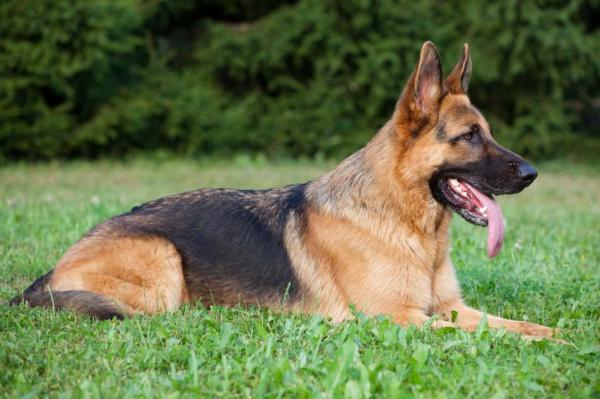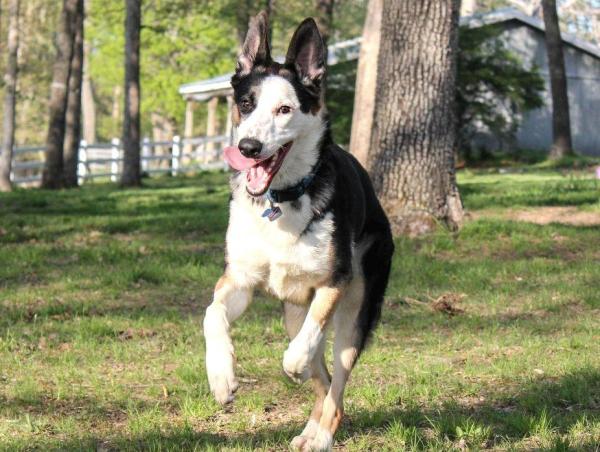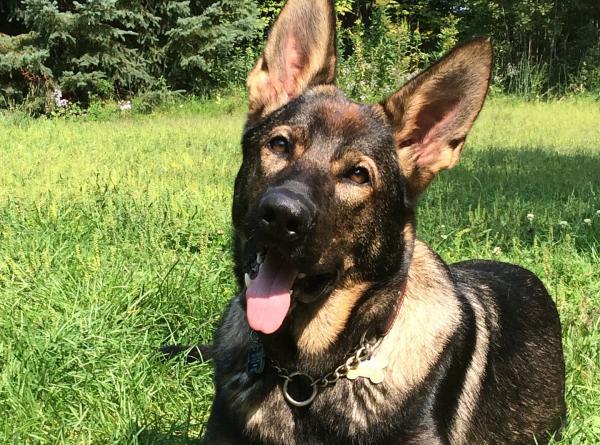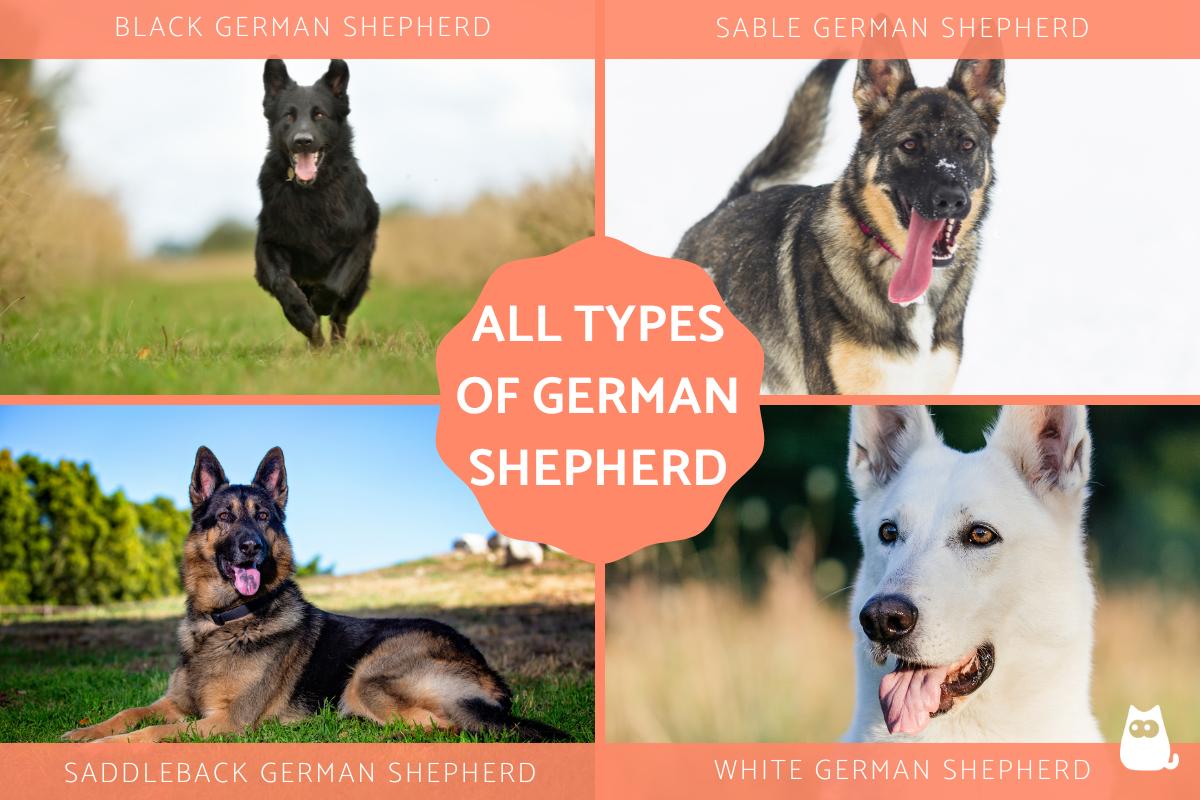Types of German Shepherds



Animal file: German Shepherd
The German Shepherd is one of the most widely recognized dogs in the world. Thanks to a rich history and a large cultural impact in various global societies, they are also one of the most respected. This is partly due to their intelligence, compatibility with humans and usefulness as a working dog. There are only two officially recognized German Shepherd dog breeds, but there are many ways you can differentiate them. Here we look into the different types of German Shepherd dogs to see what breed variations exist, some of which may become officially recognized in the future. AnimalWised also takes a look at dogs similar to the German Shepherd which often get confused.
- History of the German Shepherd Dog breed
- How many types of German Shepherd are there?
- Saddle Back German Shepherd Dog
- Solid Color German Shepherd Dog
- Panda German Shepherd Dog
- Sable German Shepherd
- Dog breeds similar to the German Shepherd Dog
- Working and show lines of German Shepherds
- Is there a Dwarf German Shepherd?
History of the German Shepherd Dog breed
The German Shepherd Dog (GSD) is the officially recognized name for this purebred breed. The two distinct types we mentioned in the introduction are defined by the length of their coat; either medium or long. Both types have a double layered coat, a softer and thicker undercoat and a coarser outer layer of guard hair.
As their name suggests, the German Shepherd began in Germany. While there were different progenitor breeds, the first officially recognized dog was called Horand von Grafrath. In 1899 von Grafrath's owner started the breed as the epitome of what a working dog should be and it is from this one dog that all modern German Shepherd dogs originate. There has been some discussion over the years whether this dog may have been part wolf.
The working origins of this breed are very important as the standardization was established to promote the dog's ability. This was something which was becoming lost as industry and urbanization began to reduce the need for working dogs. Thus, the German Shepherd was created to ensure these traits were maintained. While many GSDs are now kept as companion animals, they are still one of the most widely used working dogs in many different areas. Shepherding is not as common a practice as when the breed was established, but use in law enforcement, security and rescue operations is widespread.
It wasn't just physical ability which made the German Shepherd breed so popular. Their incredible loyalty and desire for engagement means they are relatively easy to train. For the same reasons, they need to be well-socialized and given sufficient physical and mental stimulation. Without these practices, they can develop behavioral problems.
How many types of German Shepherd are there?
While the medium and longhair varieties are the only recognized length of coat for purebred German Shepherds, the color of said coat can be varied. Not all will be allowed in competition, with some color variations being considered to be faults affecting their scoring. In terms of coat color, there are the following different types of German Shepherd:
- Saddle Back German Shepherd Dog
- Black German Shepherd Dog
- Sable German Shepherd Dog
- Panda German Shepherd Dog
- White German Shepherd Dog
It should be noted that not all types of German Shepherds are accepted by all breed associations such as the FCI (known as the World Canine Organization in English). Similarly, there are dogs which look very similar to the German Shepherd, but are not considered part of the breed. We will discuss these breeds further below.
1. Saddle Back German Shepherd Dog
This by far the most common of all types of German Shepherd. While they are usually of two colors, it is the distinctiveness of their markings which gives them this name. The saddle part refers to a patch of black fur which lays over their back, resembling the shape of a saddle on a horse. Some people refer to this as a ‘blanket’ pattern, interpreting the shape as of a blanket were laid over their back.
The other color of Saddle Back German Shepherds are usually either tan or red. In many dog shows and competitions, the more vibrant the color, the better the scoring. Liver color is not welcomed and may be used to deduct points in German Shepherd show dogs. They usually also have a black muzzle which covers their snout and parts of their face. Other areas such as their tail may exhibit black coloration.

2. Solid Color German Shepherd Dog
The solid color German Shepherd dog is less common than the Saddle Back, but they shouldn't have any other differentiating characteristics. Their health status and temperament should not be informed by color. It is possible to have powder blue colors in the dog's coat, but it is unlikely this will be solid. While a GSD may be accepted in competition, they will likely be marked down for both this color and liver. However, for solid colors, you tend to only get solid black or solid white German Shepherds.
Solid black German Shepherds are accepted in competition. However, solid white German Shepherds are one of the few color variations which tend to be immediately disqualified. While black GSDs are due to a recessive gene, white GSDs are thanks to a dominant gene which exists in some litters. It should not be confused with albinism. Neither should it be confused with the Berger Blanc Suisse, also known as a White Swiss Shepherd. Perhaps partly due to their disqualification from competition, solid white Germans Shepherds are not very common.

3. Panda German Shepherd Dog
Another of our types of German Shepherd which is not very common is the Panda German Shepherd. They have a curious and striking appearance which is often confused with other dog breeds. Due to a genetic mutation, but they are a full German Shepherd and are not a mixed breed. The mutation occurred in a litter from the USA. This type of German Shepherd exhibits a white coat on the abdomen and legs, but has black or tan on other parts, giving them a sort of panda like appearance.
Like other German Shepherd Dogs, they are agile, strong and ideal family pets. However, they arouse controversy over some breeders as white markings are considered a fault. The main controversy appears to be the belief that the dog is from inferior stock, but so far their health seems to be average when compared to other types of GSD.

4. Sable German Shepherd
The technical term for Sable German Shepherds is ‘agouti’. The sable pattern does not manifest in patches like the saddle back. Instead they have various multicolored hairs over their bodies which gives a variegated all-over appearance. This color tends to develop as they get older and some may be stronger than others. The color may be a combination of tan, gray, black, or gold. However, all Sable German Shepherds start off as tan and then develop darker colors as they age.
The variations among Sable GSDs are wide, but they are due to a dominant gene. They are believed to be dominiant over German Shepherd colors and variations.

Dog breeds similar to the German Shepherd Dog
While there are different accepted and unofficial coat patterns in the German Shepherd, it can be easy to confuse them with some other breeds which closely resemble them. This common confusions are due to similar body shape and size, with similar usage as working dogs. Some may even derive from similar parts of the world, but they are all considered distinct breeds. They include:
Belgian Shepherd
This breed originated from Belgium, with its first breed description being recorded several years before the German Shepherd, although its breed standard was officially established after. They are excellent worker dogs, especially in herding, but are also well-known for their even temperament, playfulness and faithful personality.
As with the German Shepherd, there are breed variations within the one breed. The four main types are:
- Malinois
- Groenendael
- Tervuren
- Laekenois
Depending on the location of the breed association, these breeds may all be considered part of the one Belgian Shepherd breed or they may be considered separate breeds themselves. Part of the confusion with the German Shepherd is the markings, with the Malinois in particular having a similar black mask on their face.
Czechoslovakian Wolfhound
This dog originates from the now defunct country of Czechoslovakia. It has been used as a working dog, especially as a guard dog to be used in border territories or to be used by the police. The breed comes from the crossing of the German Shepherd and the Eurasian wolf. Their inception is not necessarily the nicest one since they were bred to be used as attack dogs in special forces initiatives.
Due to their wild heritage, they are keen natural hunters. This personality trait needs to be discouraged when they are young. They can be loving and protective with their families, but can show aggression with strangers. They require experienced guardians who have the time and energy to devote to extensive training and care.
Dutch Shepherd
This is a dog which shares origins with different breeds such as the Belgian Shepherd and German Shepherd. This is evident in its physical characteristics which present in an equally muscular body and raised ears. This breed is distinguished by its coat with the most common variety being a tabby pattern with black, chestnut or yellow coloring distributed over their body.

Working and show lines of German Shepherds
In addition to the length of their coat and its coloring, the German Shepherd is also sometimes categorized by its body type. This body can be more or less stylized, tending to be more or less muscular. The more muscular the dogs are considered to be working lines and the less muscular are show lines. They are not officially different types of German Shepherd dogs, but they do exhibit small differences.
Focusing on working dog lines, they tend to have larger muscle mass and a more structured body. This means they are more commonly used by police or security forces. There are differing opinions on whether temperament differs between working and show breeds. While both types will require training and education, some believe working dog lines can tend to be more aggressive and better suited for security. Conversely, show dogs are thought to have a more docile temperament.
Whether a working or show dog, German Shepherds are not ideal dogs for first-time owners. These dogs need a lot of attention, proper socialization and careful training. Without it, they are prone to behavioral disorders. They can be wonderful and loving companion animals, but their need for attention and structure does not suit every temperament.
Not all types of German Shepherd are show dogs, but even within this category there are variations. Show dogs can be either:
- Conformation: purebred German Shepherds used in conformation shows are bred to have a particular physical standard. Unfortunately, these dogs have breen bred to the point that deformities and health problems have practically been encouraged. This was brought to international attention with the 2016 Crufts dog show in the UK where a winning GSD was visibly deformed, causing outcry in the public[1].
- Competition: for this type of purebred German Shepherd show dog, the animal needs to carry out certain physical tasks to compete against rival dogs.
The working lines of dogs are now bred all over world, there are some original working lines which are more traditional. The categories of German Shepherd working dogs are:
- West German working lines
- East German working lines
- Czech working lines
West German working lines are believed to be the most similar to the original breed standard of purebred German Shepherds. East German working lines are noted for their emphasis on good temperament and practical workability. Czech working lines are though to be the most wolf-like of the different types of German Shepherds.
Show lines have origins in Europe also, specifically in West Germany. However, due to their popularity in North American, German Shepherd show lines have also sprung up from the US and Canada.

Is there a Dwarf German Shepherd?
There is no recognized Dwarf German Shepherd breed. As with humans, German Shepherds can have genetic mutations which lead to conditions such as dwarfism. Unfortunately, dwarfism in German Shepherds negatively affects their heath in a very serious way, causing many problems and even resulting in pain. They have a much lower life expectancy and are not believed to live past 5 years. For this reason, breeding of these dogs is discouraged, being considered cruel.

If you want to read similar articles to Types of German Shepherds, we recommend you visit our Comparisons category.
1. Anonymous. (2016). Celebrations - and Controversy - at the 125th Crufts Dog Show. Veterinary Record, 178(12), 281.
https://veterinaryrecord.bmj.com/content/178/12/281
- Fédération Cynologique Internationale. (2010). German Shepherd Dog. Retrieved December 3, 2019, from http://www.fci.be/Nomenclature/Standards/166g01-en.pdf
- Shepards, S. (2019). Types of German Shepard. Dog varieties guide. Retrieved December 3, 2019 from https://pethelpful.com/dogs/Types-of-German-Shepherds-German-Shepherd-Dog-Varieties-Guide






 How to get my dog from eating my porch
How to get my dog from eating my porch

 what kind of breed is my german shepard and how do i train she is ready for training and how can i tell when she is sick or has health issues
what kind of breed is my german shepard and how do i train she is ready for training and how can i tell when she is sick or has health issues







